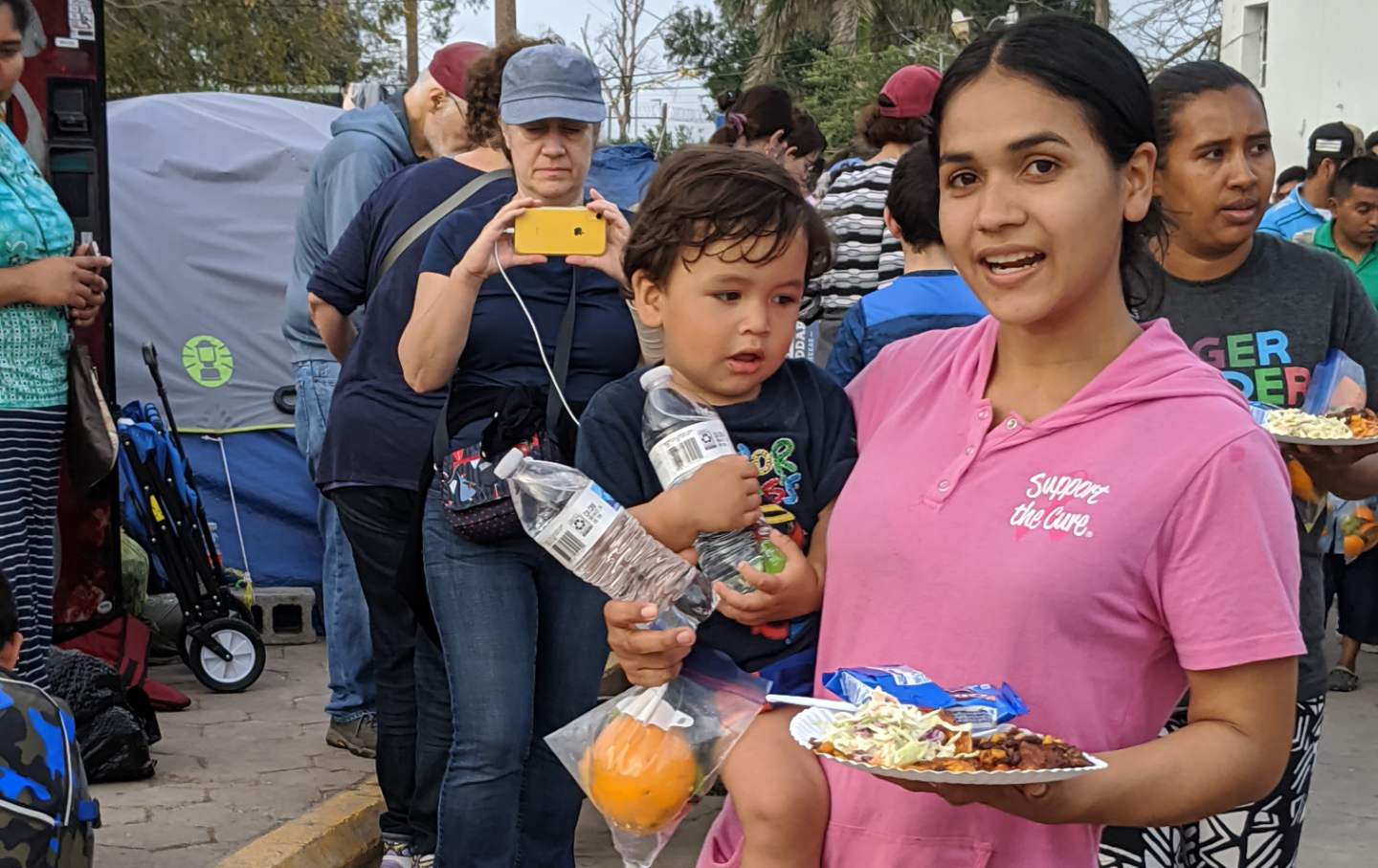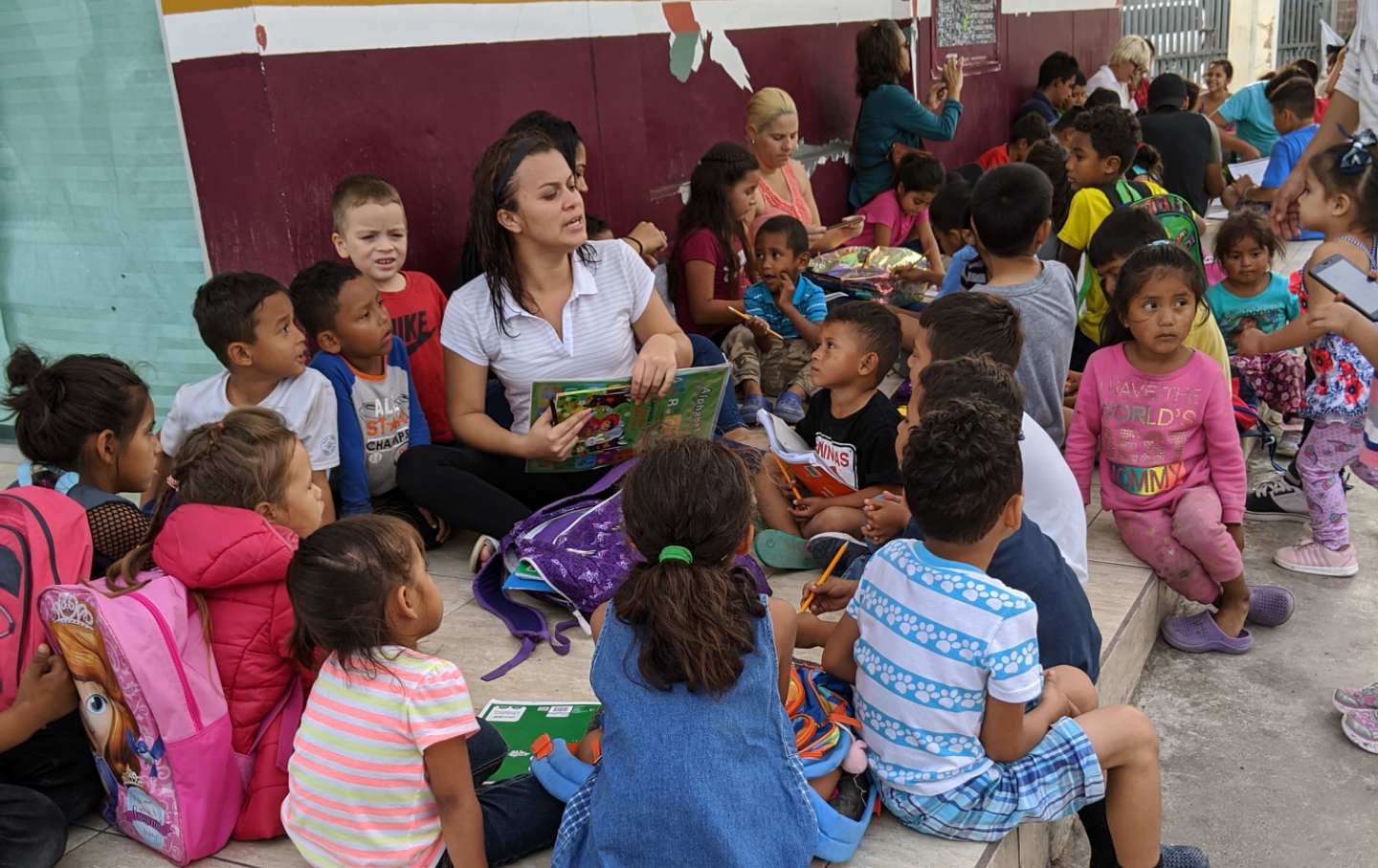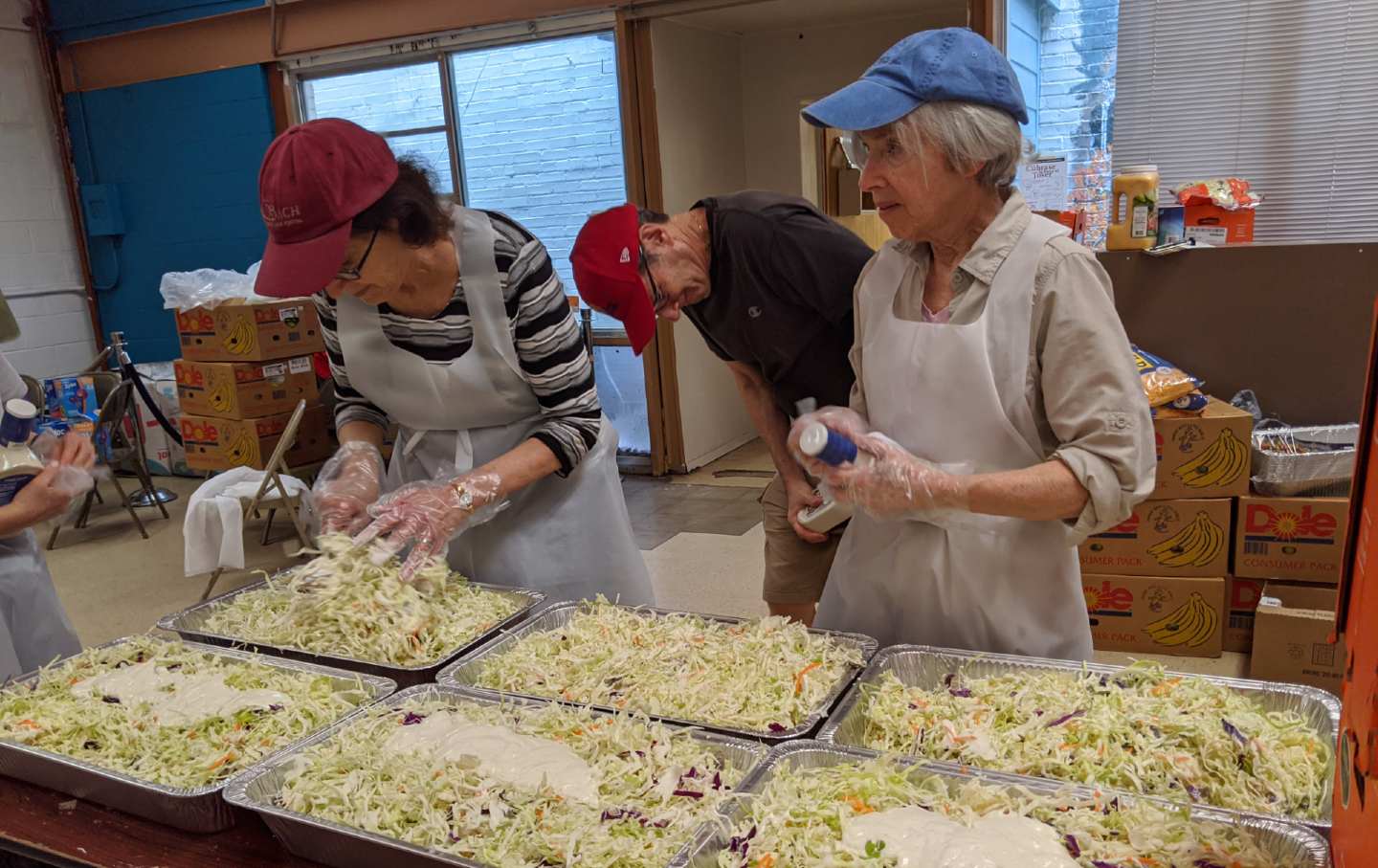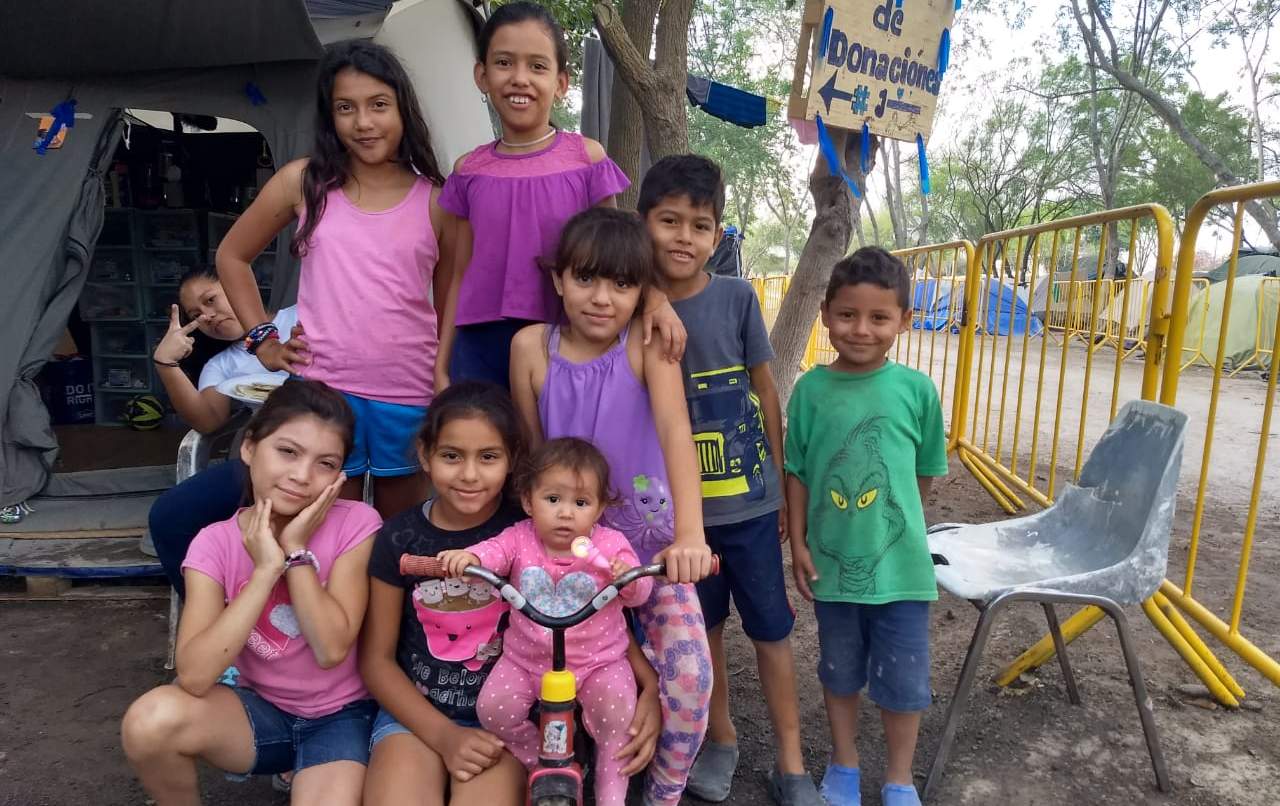EDITOR’S NOTE: The Nation believes that helping readers stay informed about the impact of the coronavirus crisis is a form of public service. For that reason, this article, and all of our coronavirus coverage, is now free. Please subscribe to support our writers and staff, and stay healthy.
The Matamoros refugee camp in Mexico sits behind a dirt levee on the banks of the Rio Grande across from Brownsville, Texas. It is home to 2,500 people, most fleeing cartel violence from Central America. It began in 2018 as a result of Trump administration policies that forced asylum-seekers to wait in Mexico as their cases progressed in US courts. For months it was a lively if desperate town, filled with hundreds of children, pop-up schools and restaurants, and aid groups. Now, like much of the world, it has fallen quiet under the shroud of the pandemic. Sam Bishop, a former US Army Ranger advanced-practice paramedic and project coordinator for Global Resource Management, which runs the medical clinic in the camp, says, “The coronavirus can burn through it.”
Bishop says, “It’s a perfect storm of where something can go really, really bad. There is no real access to the full spectrum of medical care, there’s no potential for social distancing, and it’s a disadvantaged population.” Bishop says that, based on how influenza spreads in similarly dense and underserved populations such as prisons, GRM thinks “70 percent of the camp could be infected in four weeks.” He adds grimly, “We may be looking at a higher mortality than usual.”
A visit to the camp bore out conditions ripe for the spread of communicable disease. The residents live in hundreds of tents inches apart. Port-a-potties and laundry sinks are packed together. Adults wait for phones to charge at a single bank of electrical outlets bristling with cords. Children race around the camp. Fewer people gather to play cards or eat at the makeshift restaurants with names like Vista El Norte and Restaurante El Paso, as they did weeks ago, but some residents still hold religious services despite being advised not to. One says, “They are all in support of it because they feel they need to follow the word of God in this time.”
The New York Times reports that there are “patients with Covid-19 symptoms” in the camp, but there are no confirmed cases. Bishop says, “The Mexican government has tested seven patients in the camp based on symptomatic criteria consistent with Covid-19; all seven have come back negative.” Nonetheless, most US-based aid groups have shifted to remote assistance as a precaution. Sergio Cordova, cofounder of Team Brownsville, says his aid group has been serving migrants dinner every night for more than a year. Aided by volunteers from around the country, Team Brownsville would buy and prepare dinner for a thousand people, haul it over the Gateway International Bridge to Matamoros in a procession of hand carts, and serve it to the migrants at the foot of the bridge. Now, the group pays a local restaurant, Gorditas de Raquel, to prepare. Similarly, World Central Kitchen, which received acclaim for serving 3.7 million meals in Puerto Rico after it was battered by Hurricane Maria in 2017, reportedly withdrew its foreign-based staff from Matamoros in late March, weeks after building a dining hall in the camp that is now managed by residents.
Popular
"swipe left below to view more authors"Swipe →
Despite the danger of the pandemic, camp residents have more immediate fears. Josue Rolando Cornejo Savillón, 27, has been living in Matamoros with his wife, Yamaly Flores, 34, and their three children, all seeking refuge from gangs in Honduras who killed their family members. Speaking inside his tent over video, Rolando says they are “extremely worried” about the coronavirus, but “more than anything, we are worried about our physical safety, about violence. There is a gang that controls the camp. They rape women, they beat up men.”
The dangers are a result of Trump administration policies. In April 2019 it introduced the Migrant Protection Protocols, also known as “Remain in Mexico,” forcing 61,000 asylum-seekers such as Yamaly and Rolando back to Mexico to await hearings on their asylum applications. The White House alleges the policy ensures that “vulnerable populations will get the protection they need while they await a determination in Mexico.” But the ACLU argues MPP is “almost certainly illegal,” as forcing migrants to Mexico places them in grave danger. More than 1,000 cases of violence, including rape, assault, and kidnapping, have been recorded against asylum-seekers. According to the advocacy group Human Rights First, “The number of attacks on asylum-seekers and migrants returned to Mexico is certainly far above 1,000, as the vast majority of those returned have not been interviewed by researchers or journalists.” Barely 1 percent of asylum-seekers coming through the southern border gain legal entry under MPP. Now, this slim hope has vanished, as Trump has used the pretext of the pandemic to shut down entry to virtually all migrant children and asylum-seekers.
Weeks earlier, when we’re visiting the camp, Yamaly explains to us why her family fled Honduras in May 2019. She sits in a white plastic chair in front of Store One, a green nylon tent that serves as a distribution center. Men and women toting children stream by for free diapers, toothpaste, soap, and other essentials. Yamaly has just come back from a hearing on her application for asylum in the United States. Her pink glitter high-tops, which are missing shoelaces, accent the purple tropical flowers on her white blouse (all the asylum-seekers who enter the tent courts where judges preside by video are stripped of belts and shoelaces).
When asked what will happen if they are forced to return to Honduras, Yamaly says, “We would immediately get on a bus and leave again. We don’t have a choice. We are in too much danger.” She fidgets and her eyes dart side to side as Kelly Escobar, who is translating, says, “She doesn’t want to say what would happen if they were forced to stay.” Yamaly says that despite the dangers in the camp, it’s safer compared to the extreme violence they fled.
Yamaly worked as a seamstress in an underwear factory in San Pedro Sula, a city of 800,000 in northern Honduras. Rolando drove a minibus. She lost her job four years ago when the factory went bankrupt. “It’s very difficult to find work. There were days we didn’t have enough money for food or water, and I had to ask neighbors for food, so the kids did not have to go to school hungry.”
Rolando was forced to pay a “war tax” of $25 a week each to Mara Salvatrucha, or MS-13, and the 18th Street gang, transnational gangs that control his neighborhood. It left him with little money, and he stopped driving because gangs were killing bus drivers who refused to pay. He says, “Our home was in the middle of a war zone between the gangs.”
The violence began closing in on the family. His adopted father is a pastor who does anti-gang work in San Pedro Sula. On May 5, 2019, in retaliation, Rolando’s uncle and aunt were killed by the 18th Street gang at home in front of two children. Rolando says everyone in his family is dead except a few members who have taken refuge in Mexico. Gangs then targeted Yamaly’s 14-year-old son, David, for recruitment. His father, uncle, and three cousins had all been killed by gangs, and the rest of the family has fled to Chiapas, Mexico. Gang members beat David in the streets, asking, “Are you ready?” They told him if he didn’t join, they would kill him.
Days later, after borrowing money from friends and without saying goodbye to their families, they escaped from Honduras by bus along with David and their two young daughters. They bribed border guards to leave with their children, and paid smugglers to help them cross into Guatemala and then again into Mexico. “Every step of the way we had to pay something,” says Yamaly. “If we didn’t have the money to pay them, they would have killed us.” To cross into the United States, they borrowed $1,500 to pay more smugglers. After applying for asylum, the family was deported to Matamoros under MPP.
As Yamaly tells her story, Antonio stops by Store One for toilet paper. He and six family members also escaped gang violence in Central America. They were targeted for filing a police report after gangs killed a relative. Antonio’s work as a civil servant high up in his government didn’t protect him. They arrived in the city of Monterrey last August, about a hundred miles from the US border. Within minutes of disembarking from a bus, two pickup trucks full of men armed with semiautomatic handguns accosted them. The family, including four children, were taken to a hideout their kidnappers called la bodega.
“We were scared. We were thinking the worst,” says Antonio. “These types of people don’t care about life.”
The gang forced them to call relatives in the United States, demanding $20,000 in ransom. They were held for 22 days. “No food, no water, they beat us,” says Antonio. Their relatives scraped together $6,000 in ransom to secure the release of Antonio and two children. The rest of the family escaped days later, having studied the routine of the kidnappers. Antonio says, “The children are deeply disturbed.”
Antonio and his family entered the United States through Laredo on August 25 and were returned to Nuevo Laredo under MPP days later, barely avoiding another kidnapping. After cases are heard in Laredo, asylum-seekers are discharged over the bridge into Mexico. He said, “Migrants are being kidnapped right out of court.” A discussion ensued at the tent. The migrants said that taking their shoelaces, ostensibly because it’s a suicide risk, marks them as targets to the gangs. “The criminals know who the migrants are because they are missing their shoelaces,” said one.
Yamaly and Antonio’s families have called the Matamoros camp home for nine months. Between the Rio Grande and a wide avenue of checkpoints, police, and cameras leading to the United States are migrants from Brazil to Haiti, Africa to Asia. They live in tents covered in blue tarps on top of wood pallets and cluster together based on nationality. The vast majority are from Honduras, Guatemala, El Salvador, and southern Mexico. It’s called the Green Zone, for the grass and trees that are a rarity in Matamoros, but some joke that it’s the brown zone; paths crisscrossing the camp have been worn down to gray, cracked dirt that whips up dust when it’s windy and turns to mud that sucks off shoes when it rains.
Yamaly says, “It’s hard to live in a tent. We don’t have beds, a shower, a place to change our clothes. The kids have missed almost two years of school.”
UNICEF estimates there are 700 children in the camp, making social distancing impossible. Kids play with a radio-controlled toy car near the bridge. They sit on the curb clutching baggies of cut-up fruit and eating cheese and bean enchiladas prepared by members of Adas Israel, a Washington, DC–area synagogue. They pore over textbooks learning math and English at the Sidewalk School, which provides many of the children with their first taste of formal education.
Felicia Rangel-Samponaro started the school in 2018. She says that after seeing the camp, “it’s hard to go back to your normal life.” She moved to the border area from Houston and hired asylum-seekers as teachers, paying them herself at first. Donors now cover the $1,500 weekly cost of teachers’ pay, books and computers, and food for the 80 children who attend the school five days a week for 90 minutes.
The school has adapted to the pandemic. Rangel-Samponaro says, “We got a donation of over 100 tablets so we can be fully online. No one wants school to stop. No one needs to be in contact with each other anymore. We’ve handed out hundreds of masks and pairs of gloves to students.”
Cordova of Team Brownsville says that in July 2018 asylum-seekers began living on the bridge connecting Matamoros to the point of entry in Brownsville. Families were afraid of losing their place in line because the Trump administration had introduced a metering policy to drastically reduce the entry of asylum-seekers at ports of entry. “Once they get on US soil, the asylum process has to begin, so customs agents were stopping that process from even beginning,” he says. “At first, families were waiting days to cross in, then a week, then a month, and eventually two months, three months. It was crazy.”
Angry Tias and Abuelas of the Rio Grande Valley began helping migrants on the bridge. Cordova says, “It was a hundred degrees in the sun. They were sleeping on the concrete in the open. People were baking. They were getting skin rashes. They were getting bad headaches, stomach problems, respiratory problems. We started bringing water, food, diapers. We brought tarps to protect them from the sun, blankets and mats to sleep on. We’ve brought over 700 tents since last July.”
That camp grew slowly, to a few hundred people, with migrants cycling in and out as they entered the United States to pursue asylum. Then, in the summer of 2019, it exploded to a couple thousand people after MPP was enacted at the Brownsville crossing. The camp has also receded from the bridge. For months it took over much of the main plaza in Matamoros before everyone was moved behind the levee.
In the camp, girls lug around toddlers half their size. Young boys tug at T-shirts as they watch Adrian, 19, who was deported last year after living in Texas since age 2, bury the slick, bloated corpse of a beaver. (Three interviewees were undocumented Americans deported after decades of living in the United States.) On the bridge hundreds of Mexicans line up for hours waiting to enter the United States for work or business as Americans flash their passports at border guards to breeze by. Underneath, women beat laundry on rocks. A girl wades through the waist-deep river as another girl hangs around her waist, being pulled through the murky green water. They laugh until they are out of breath.
Last June, a half-mile downriver, the bodies of 25-year-old Óscar Alberto Martínez Ramírez and 23-month-old Valeria, Salvadoran migrants who were trying to enter the United States, washed up face down on the riverbank. They had reportedly tried to cross after two months of waiting in Matamoros, frustrated by the metering policy.
Camilo Pérez-Bustillo, a fellow at the Center for Advanced Study in the Behavioral Sciences at Stanford University, researches the political economy of migration and terror along the US-Mexico border and in Europe and Australia. He says migrants are being targeted as a result of Mexico’s war on drug cartels. That war began in 2006 and has received $3.1 billion in US funding, military hardware, and training. Since then, an estimated 150,000 homicides in Mexico have been linked to organized crime, along with at least 40,000 disappearances.
Pérez-Bustillo says, “The Mexican state is not a failed state; it’s a strong state in the wrong hands.” He says the “cartelization” of the state is evidenced by the arrest last December of former Mexican secretary of public security Genaro García Luna, the “architect of Mexico’s war on drugs.” The US Department of Justice charged García Luna with taking millions of dollars in bribes from Joaquín “El Chapo” Guzmán of the Sinaloa Cartel in exchange for protecting the cartel, aiding it in trafficking tons of cocaine, and tipping it off about rival cartels.
In the context of the drug war, says Pérez-Bustillo, the thousands of migrants forced to cities like Tijuana and Matamoros are “a string of pearls along the border for the cartels to exploit.” He says kidnapping and extortion are a huge business, as an estimated 80 percent of migrants have relatives in the United States. The cartels know this, says Pérez-Bustillo, and have extorted billions of dollars from migrants and their US families through ransoms, smuggling, and bribes at borders. Trump’s policies benefit cartels, he says: “Sealing the border is handing the migrants to the cartels to exploit. Making the border more difficult to cross makes trafficking easier.”
In the camp two Cuban men say they were also abducted in Monterrey, held for days, and beaten until relatives in the United States paid $4,000 each. They claim the kidnappers were the police.
Every refugee from the Northern Triangle countries (El Salvador, Honduras, and Guatemala) who spoke to The Nation was displaced by cartel violence and paid them under duress at borders, as with Yamaly’s family, or at gunpoint, as with Antonio’s family. Recent refugees in the camp are from southern Mexico. Maria left Guerrero with her children after her family was threatened by cartel members. Rosa, from Michoacán, says a gang killed the father of her two children “in front of their school.” She says that despite the difficult conditions in the camp, which included not having drinking water for days, she was glad to be there because it was safer for her children.
The camp includes a smattering of political asylum-seekers. Annaelle Fleurismat Sancois fled from Haiti to Chile, fearing for her life after participating in anti-austerity protests. Her month-long journey to Matamoros included 15 days walking across Panama’s mountains while carrying her infant daughter, Elianise. Edinson Daniel Perez-Blanco, who was a professor of business law in Venezuela before fleeing his country, says government supporters attacked him for protesting. He had an easier trip, catching a plane from Bogotá to Mexico City. He estimated there were 50 other Venezuelan refugees in Matamoros, all living in the town itself, like him. Sam Bishop estimates that aid groups assist a thousand refugees who live in the town but not the camp. Numerous sources claim there are a thousand Cuban refugees in Matamoros, with up to seven living in one-bedroom apartments.
Perez-Blanco says, “Venezuelans are getting asylum.” The evidence backs him up: Since MPP began, more than 41,000 cases have been pushed through the courts or terminated, and only 481 refugees have been granted asylum. But of those, 84 percent are from Venezuela or Cuba. Among 34,000 asylum-seekers in MPP from Honduras, El Salvador, and Guatemala whose cases have been closed, 41 have been given asylum. That’s about one in a thousand.
A legal advocate for immigrants working in Brownsville says the goal of the new legal process is to “dismantle asylum.” The advocate, who requested anonymity because they didn’t have permission to speak on behalf of their organization, said that under MPP, “the aim is to get you through the entire asylum process in a week. You will get an hour to make phone calls to attorneys listed on a piece of paper. Your access to legal representation is pretty much nonexistent. If your asylum case is rejected, you are put on a plane flight, shackled. They are not told where they are going, is what we hear. They’re being disappeared. All the elements of due process are stripped out.” Under Trump’s pandemic emergency measures, migrants “are being expelled to Mexico in an average of 96 minutes,” according to The Washington Post.
In the first half of February, 98 Hondurans and Salvadorans were deported from the Brownsville airport to Guatemala. Refugees are reportedly not told where they are going, and upon arrival in Guatemala, they have three days to navigate “a rushed and confusing” asylum process termed “a total disaster” by Thelma Shau, who handles migration issues for Guatemala’s human rights ombudsman.
Caught for months in a camp stalked by violence and plagued by respiratory and gastrointestinal diseases, and with slim chances of asylum, parents were sending children across the US border as unaccompanied minors, and children had also been crossing without telling parents. It was a gamble that children were better off navigating a US detention system—where there were 1,673 reported cases of sexual abuse in fiscal year 2018 and where six children died in less than one year—than staying in violence-racked border cities. In one Border Patrol sector, the number of unaccompanied children in February 2020 surged 107 percent over the same time last year.
But that Sophie’s choice is no longer an option. Now the Trump administration is deporting unaccompanied migrant children. Eleanor Acer of Human Rights First says the White House is using the coronavirus as an excuse “to advance their long-standing goal of overturning US laws protecting vulnerable children and people seeking asylum.”
Rangel-Samponaro says the Sidewalk School is texting parents, warning them that unaccompanied children will be deported to their home countries alone. She says hundreds of migrants are “self-deporting,” as the Mexican government has stepped up its tactic of sending buses to the camp and encouraging refugees to relocate to southern Mexico. On March 30, around 100 Mexican asylum-seekers left the camp on government buses.
Yamaly and Ronaldo remain in the camp. They cling to the hope for asylum. Their final hearing has been postponed to April 28 because of the pandemic. “All our hopes are to get in the United States,” says Yamaly. “There is no future for our children in Mexico. It’s not much different from our country. The United States is the land of laws. It’s the promised land.”
On February 28, a federal appeals court agreed and ruled against MPP. It found that the policy violated US law and that “those returned to Mexico under the MPP risk substantial harm, even death.” But on March 11, the Supreme Court, after an emergency appeal by the Trump administration, stayed enforcement of the appeals court’s ruling while lower court challenges continue, dashing the hopes of thousands of refugees trapped in Mexico.






